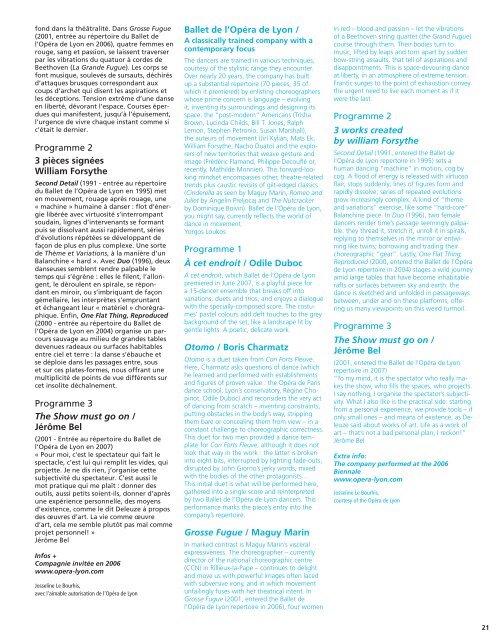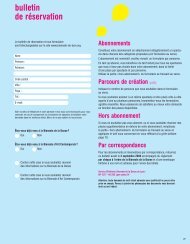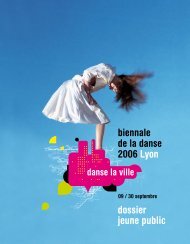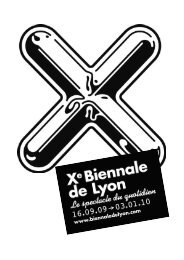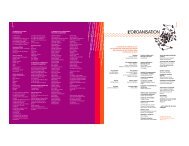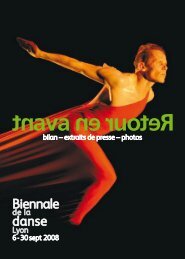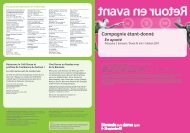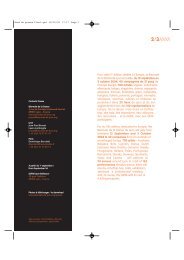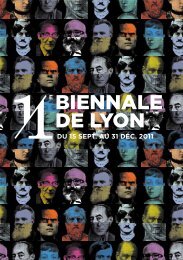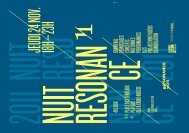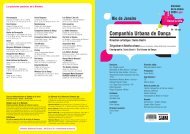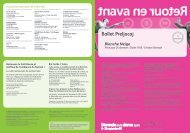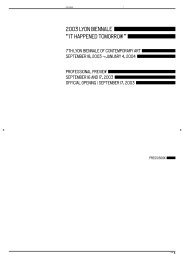Retour en Avant / Past Forward Biennale de la Danse Lyon - France
Retour en Avant / Past Forward Biennale de la Danse Lyon - France
Retour en Avant / Past Forward Biennale de la Danse Lyon - France
- No tags were found...
Create successful ePaper yourself
Turn your PDF publications into a flip-book with our unique Google optimized e-Paper software.
fond dans <strong>la</strong> théâtralité. Dans Grosse Fugue(2001, <strong>en</strong>trée au répertoire du Ballet <strong>de</strong>l’Opéra <strong>de</strong> <strong>Lyon</strong> <strong>en</strong> 2006), quatre femmes <strong>en</strong>rouge, sang et passion, se <strong>la</strong>iss<strong>en</strong>t traverserpar les vibrations du quatuor à cor<strong>de</strong>s <strong>de</strong>Beethov<strong>en</strong> (La Gran<strong>de</strong> Fugue). Les corps sefont musique, soulevés <strong>de</strong> sursauts, déchirésd’attaques brusques correspondant auxcoups d’archet qui dis<strong>en</strong>t les aspirations etles déceptions. T<strong>en</strong>sion extrême d’une danse<strong>en</strong> liberté, dévorant l’espace. Courses éperduesqui manifest<strong>en</strong>t, jusqu’à l’épuisem<strong>en</strong>t,l’urg<strong>en</strong>ce <strong>de</strong> vivre chaque instant comme sic’était le <strong>de</strong>rnier.Programme 23 pièces signéesWilliam ForsytheSecond Detail (1991 - <strong>en</strong>trée au répertoiredu Ballet <strong>de</strong> l’Opéra <strong>de</strong> <strong>Lyon</strong> <strong>en</strong> 1995) met<strong>en</strong> mouvem<strong>en</strong>t, rouage après rouage, une« machine » humaine à danser : flot d’énergielibérée avec virtuosité s’interrompantsoudain, lignes d’interv<strong>en</strong>ants se formantpuis se dissolvant aussi rapi<strong>de</strong>m<strong>en</strong>t, sériesd’évolutions répétées se développant <strong>de</strong>façon <strong>de</strong> plus <strong>en</strong> plus complexe. Une sorte<strong>de</strong> Thème et Variations, à <strong>la</strong> manière d’unBa<strong>la</strong>nchine « hard ». Avec Duo (1996), <strong>de</strong>uxdanseuses sembl<strong>en</strong>t r<strong>en</strong>dre palpable letemps qui s’égrène : elles le fil<strong>en</strong>t, l’allong<strong>en</strong>t,le déroul<strong>en</strong>t <strong>en</strong> spirale, se répondant<strong>en</strong> miroir, ou s’imbriquant <strong>de</strong> façongémel<strong>la</strong>ire, les interprètes s’empruntantet échangeant leur « matériel » chorégraphique.Enfin, One F<strong>la</strong>t Thing, Reproduced(2000 - <strong>en</strong>trée au répertoire du Ballet <strong>de</strong>l’Opéra <strong>de</strong> <strong>Lyon</strong> <strong>en</strong> 2004) organise un parcourssauvage au milieu <strong>de</strong> gran<strong>de</strong>s tables<strong>de</strong>v<strong>en</strong>ues ra<strong>de</strong>aux ou surfaces habitables<strong>en</strong>tre ciel et terre : <strong>la</strong> danse s’ébauche etse déploie dans les passages <strong>en</strong>tre, souset sur ces p<strong>la</strong>tes-formes, nous offrant unemultiplicité <strong>de</strong> points <strong>de</strong> vue différ<strong>en</strong>ts surcet insolite déchaînem<strong>en</strong>t.Programme 3The Show must go on /Jérôme Bel(2001 - Entrée au répertoire du Ballet <strong>de</strong>l’Opéra <strong>de</strong> <strong>Lyon</strong> <strong>en</strong> 2007)« Pour moi, c’est le spectateur qui fait lespectacle, c’est lui qui remplit les vi<strong>de</strong>s, quiprojette. Je ne dis ri<strong>en</strong>, j’organise cettesubjectivité du spectateur. C’est aussi lemot pratique qui me p<strong>la</strong>ît : donner <strong>de</strong>soutils, aussi petits soi<strong>en</strong>t-ils, donner d’aprèsune expéri<strong>en</strong>ce personnelle, <strong>de</strong>s moy<strong>en</strong>sd’exist<strong>en</strong>ce, comme le dit Deleuze à propos<strong>de</strong>s œuvres d’art. La vie comme œuvred’art, ce<strong>la</strong> me semble plutôt pas mal commeprojet personnel! »Jérôme BelInfos +Compagnie invitée <strong>en</strong> 2006www.opera-lyon.comJosseline Le Bourhis,avec l’aimable autorisation <strong>de</strong> l’Opéra <strong>de</strong> <strong>Lyon</strong>Ballet <strong>de</strong> l’Opéra <strong>de</strong> <strong>Lyon</strong> /A c<strong>la</strong>ssically trained company with acontemporary focusThe dancers are trained in various techniques,courtesy of the stylistic range they <strong>en</strong>counter.Over nearly 20 years, the company has builtup a substantial repertoire (70 pieces, 35 ofwhich it premiered) by <strong>en</strong>listing choreographerswhose prime concern is <strong>la</strong>nguage – evolvingit, inv<strong>en</strong>ting its surroundings and <strong>de</strong>signing itsspace: the “post-mo<strong>de</strong>rn“ Americans (TrishaBrown, Lucinda Childs, Bill T. Jones, RalphLemon, Steph<strong>en</strong> Petronio, Susan Marshall),the auteurs of movem<strong>en</strong>t (Jirí Kylián, Mats Ek,William Forsythe, Nacho Duato) and the explorersof new territories that weave gesture andimage (Frédéric F<strong>la</strong>mand, Philippe Decouflé or,rec<strong>en</strong>tly, Mathil<strong>de</strong> Monnier). This forward-lookingmindset <strong>en</strong>compasses other, theatre-re<strong>la</strong>tedtr<strong>en</strong>ds plus caustic revisits of gilt-edged c<strong>la</strong>ssics(Cin<strong>de</strong>rel<strong>la</strong> as se<strong>en</strong> by Maguy Marin, Romeo andJuliet by Angelin Preljocaj and The Nutcrackerby Dominique Boivin). Ballet <strong>de</strong> l’Opéra <strong>de</strong> <strong>Lyon</strong>,you might say, curr<strong>en</strong>tly reflects the world ofdance in movem<strong>en</strong>t. ■Yorgos LoukosProgramme 1À cet <strong>en</strong>droit / Odile DubocÀ cet <strong>en</strong>droit, which Ballet <strong>de</strong> l’Opéra <strong>de</strong> <strong>Lyon</strong>premiered in June 2007, is a p<strong>la</strong>yful piece fora 15-dancer <strong>en</strong>semble that breaks off intovariations, duets and trios, and <strong>en</strong>joys a dialoguewith the specially-composed score. The costumes’pastel colours add <strong>de</strong>ft touches to the greybackground of the set, like a <strong>la</strong>ndscape lit byg<strong>en</strong>tle lights. A poetic, <strong>de</strong>licate work.Otomo / Boris CharmatzOtomo is a duet tak<strong>en</strong> from Con Forts Fleuve.Here, Charmatz asks questions of dance (whichhe learned and performed with establishm<strong>en</strong>tsand figures of prov<strong>en</strong> value : the Opéra <strong>de</strong> Parisdance school, <strong>Lyon</strong>’s conservatory, Régine Chopinot,Odile Duboc) and reconsi<strong>de</strong>rs the very actof dancing from scratch – inv<strong>en</strong>ting constraints,putting obstacles in the body’s way, strippingthem bare or concealing them from view – in aconstant chall<strong>en</strong>ge to choreographic correctness.This duet for two m<strong>en</strong> provi<strong>de</strong>d a dance temp<strong>la</strong>tefor Con Forts Fleuve, although it does notlook that way in the work : the <strong>la</strong>tter is brok<strong>en</strong>into eight bits, interrupted by lighting fa<strong>de</strong>-outs,disrupted by John Giorno’s jerky words, mixedwith the bodies of the other protagonists…This initial duet is what will be performed here,gathered into a single score and reinterpretedby two Ballet <strong>de</strong> l’Opéra <strong>de</strong> <strong>Lyon</strong> dancers. Thisperformance marks the piece’s <strong>en</strong>try into thecompany’s repertoire.Grosse Fugue / Maguy MarinIn marked contrast is Maguy Marin’s visceralexpressiv<strong>en</strong>ess. The choreographer – curr<strong>en</strong>tlydirector of the national choreographic c<strong>en</strong>tre(CCN) in Rillieux-<strong>la</strong>-Pape – continues to <strong>de</strong>lightand move us with powerful images oft<strong>en</strong> <strong>la</strong>cedwith subversive irony, and in which movem<strong>en</strong>tunfailingly fuses with her theatrical int<strong>en</strong>t. InGrosse Fugue (2001, <strong>en</strong>tered the Ballet <strong>de</strong>l’Opéra <strong>de</strong> <strong>Lyon</strong> repertoire in 2006), four wom<strong>en</strong>in red – blood and passion – let the vibrationsof a Beethov<strong>en</strong> string quartet (the Grand Fugue)course through them. Their bodies turn tomusic, lifted by leaps and torn apart by sudd<strong>en</strong>bow-string assaults, that tell of aspirations anddisappointm<strong>en</strong>ts. This is space-<strong>de</strong>vouring danceat liberty, in an atmosphere of extreme t<strong>en</strong>sion.Frantic surges to the point of exhaustion conveythe urg<strong>en</strong>t need to live each mom<strong>en</strong>t as if itwere the <strong>la</strong>st.Programme 23 works createdby william ForsytheSecond Detail (1991, <strong>en</strong>tered the Ballet <strong>de</strong>l’Opéra <strong>de</strong> <strong>Lyon</strong> repertoire in 1995) sets ahuman dancing “machine” in motion, cog bycog. A flood of <strong>en</strong>ergy is released with virtuosof<strong>la</strong>ir, stops sudd<strong>en</strong>ly; lines of figures form andrapidly dissolve; series of repeated evolutionsgrow increasingly complex. A kind of “themeand variations” exercise, like some “hard-core”Ba<strong>la</strong>nchine piece. In Duo (1996), two femaledancers r<strong>en</strong><strong>de</strong>r time’s passage seemingly palpable:they thread it, stretch it, unroll it in spirals,replying to themselves in the mirror or <strong>en</strong>twininglike twins; borrowing and trading theirchoreographic “gear”. Lastly, One F<strong>la</strong>t Thing,Reproduced (2000, <strong>en</strong>tered the Ballet <strong>de</strong> l’Opéra<strong>de</strong> <strong>Lyon</strong> repertoire in 2004) stages a wild journeyamid <strong>la</strong>rge tables that have become inhabitablerafts or surfaces betwe<strong>en</strong> sky and earth: thedance is sketched and unfol<strong>de</strong>d in passagewaysbetwe<strong>en</strong>, un<strong>de</strong>r and on these p<strong>la</strong>tforms, offeringus many viewpoints on this weird turmoil.Programme 3The Show must go on /Jérôme Bel(2001, <strong>en</strong>tered the Ballet <strong>de</strong> l’Opéra <strong>de</strong> <strong>Lyon</strong>repertoire in 2007)“To my mind, it is the spectator who really makesthe show, who fills the spaces, who projects.I say nothing, I organise the spectator’s subjectivity.What I also like is the practical si<strong>de</strong>: startingfrom a personal experi<strong>en</strong>ce, we provi<strong>de</strong> tools – ifonly small ones – and means of exist<strong>en</strong>ce, as Deleuzesaid about works of art. Life as a work ofart – that’s not a bad personal p<strong>la</strong>n, I reckon!”Jérôme BelExtra info:The company performed at the 2006Bi<strong>en</strong>nalewww.opera-lyon.comJosseline Le Bourhis,courtesy of the Opéra <strong>de</strong> <strong>Lyon</strong>21


